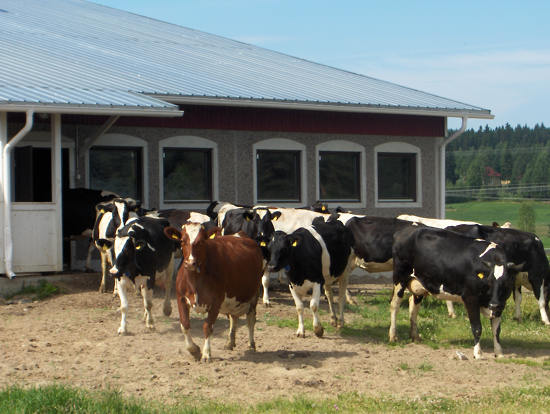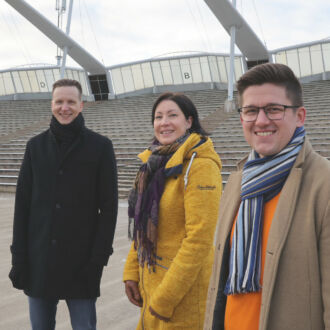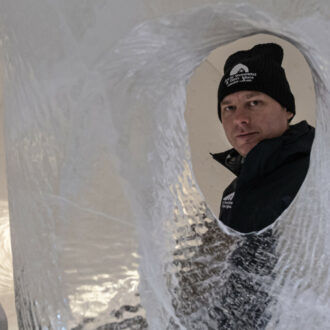Farming couple Anu and Esa Immonen run Esa’s family estate in Nilsiä in the province of Savo, a good 400 km north of Helsinki. These are the northernmost farmed areas in the world. The crops that grow in these latitudes comprise a small selection of cereals, vegetables, berries and grass for hay. The growing season is short but intense — there is enough sunlight and water during the few summer months.
Anu and Esa are peacefully drinking their afternoon coffee at the table in their cosy farmhouse living-room. They have about 50 dairy cows, but no longer have to rush to milk them. These days an automatic milking system takes care of that. The cows walk to the milking station by themselves when they feel like it; the machine cleans their udders, takes the necessary samples, milks them, and provides each cow with a programmed amount of feed concentrate. The farmer’s and his wife’s most important device is the computer that produces a real-time report on the cows’ milking behaviour and health. This level of efficiency compensates for the disadvantage of a short growing season.
“The amount of work done in the cowshed has decreased by a certain amount and the automatic milking system gives more flexibility in managing our time,” explains Esa happily. “Now I can attend the spring party at my children’s musical kindergarten, even if it is held at the traditional milking time,” he adds enthusiastically. Esa and Anu have two young daughters, Veera, 4, and Riina, 2.
From small family holding to successful business enterprise

Milk cows coming out from a byre.Photo: Salla Korpela
Nilsiä is located in a traditional dairy-farming region, which has experienced a powerful structural change in recent years. In the 1940s, the area comprised small family farms less than ten hectares in size, where people did all the work themselves and owned very little machinery. The farms of today are large in comparison, and most are equipped with the latest technology. The labour force on the farms is small, usually consisting of only a married couple, one of whom often has a second job elsewhere, at least part-time. This is the case in the Immonen family too — Esa’s other role is selling snowmobiles.
Esa and Anu have implemented changes to their farm themselves. When they took charge of the farm in August 2000, it comprised 22 dairy cows and about 40 hectares of arable land. Now the number of dairy cows has trebled, in addition to which there are 50 beef cattle, 40 heifers as well as calves. The area of land for growing grass and fodder grain for the cattle is double what it was when they started. To achieve all this Esa and Anu have invested heavily — mainly with borrowed money. But the young couple are not worried about the situation.
“We have calculated everything carefully,” explains Anu, who has an MSc in Economics and Business Administration. She takes care of the farm’s finances and the paperwork required by EU farming regulations, which these days takes up a lot of her time. Esa, who has a degree in agriculture, is responsible for planning and developing the work of the farm.
“Our most crucial asset is our skill in handling the work here. In principle, the farm functions in such a way that the everyday tasks can be managed by one person, if necessary.”
Finnish farmers supported by forest
Farms in Finland often include a sizeable area of forest. Esa’s and Anu’s farm is no different with its total of 165 hectares of forest land. Timber is sold to forest companies as raw material for paper, and to sawmills. Productive forest holdings are sources of investment reserves and security for hard times. Forest maintenance in the form of replanting and clearing must be done annually in order to ensure that the forest remains productive.
The milk from the farm’s cows is first collected in a 5,000-litre refrigerated storage tank, then transported by a milk tanker every other evening to a dairy in Lapinlahti, about 40 kilometres away.

Elements of Finnish farming: cows, fields, and forest.Photo: Salla Korpela
Esa and Anu employ temporary workers during the busiest times of the year, the sowing and harvesting seasons, and they completely outsource some services and mechanical work, such as the forest maintenance previously referred to.
Esa believes thoughtful outsourcing makes good sense. “In the past, farmers were proud of the fact that they did everything themselves. It is not possible to think like that nowadays unless you want to work yourself into an early grave. It would also be unwise for every farmer to buy all the machinery needed as some of it is just so expensive,” he explains.
The previous owners of the farm, Esa’s parents, live in their own house on the property and help out. They look after the children when Esa and Anu are busy.
Country life leaves room for hobbies
“All in all, this is a great job as there is so much freedom to plan and carry out the work and the results can be seen all around. I don’t even feel that the work is physically demanding,” explains Esa.
“And the cows don’t complain!”
In their free time, the Immonen family enjoy the opportunities of life in the country. Esa rides a motorbike in the summer, and a snowmobile in the winter, while Anu likes to ski. The family share an interest in dogs and dog shows.
Esa and Anu are even able to have a holiday. They are entitled to statutory leave of 23-24 days a year, while a municipal holiday substitute takes care of the daily routines at the farm. Esa and Anu also purchase the services of a holiday substitute for extra days off from the farm.
By Salla Korpela, July 2005



